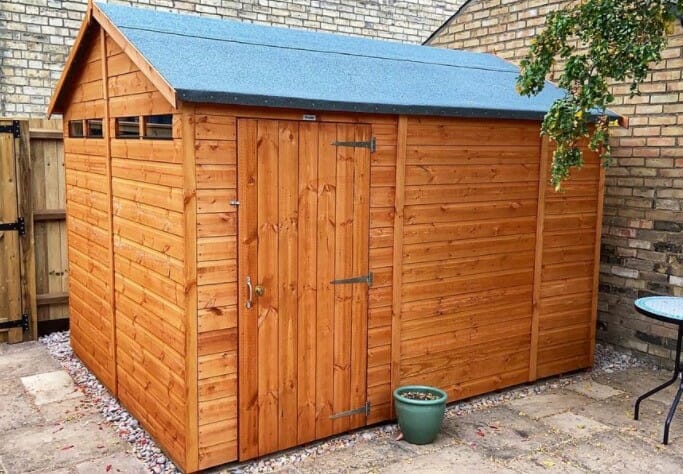Common Garden Shed Roof Questions and Answers
It goes without saying that the roof is one of the most important parts of your shed, without it the whole structure would lack integrity and, of course, it wouldn’t keep out any of the elements. For that reason, looking after your shed roof is extremely important, but there are many questions that can come up when it comes to the upkeep of your shed.
So, whether you own a pent or apex, garden shed, a summerhouse or bike shed, we’ve answered some of the most common queries to help you on your way.
My shed roof sags, what should I do?
If your shed roof is sagging, you need to first work out why it is sagging before looking into how to fix your sagging shed roof. This often occurs when there has been too much weight on the existing structure – this can be snow, ice, wind or the roofing materials on top of the wooden boards. Sometimes this wooden roof can bend, warp or simply rot.
The most common shed roofs which start to sag are shed roofs made with chipboard or OSB. Chipboard or OSB is really designed for interior use – however, it does not take much for the roof under the felt to get damp e.g. a small tear in the felt, capillary action in the roof (if the felt has not been installed correct or the pitch of the roof is small) or from condensation inside the shed due to a lack of ventilation.
To resolve the issue, you can bolster the shed roof up with additional framing. This should strengthen the roof to stop it from sagging. Alternatively, you could take off the roof and purchase tongue and groove boards, nail these into place and re-felt the shed roof. It may be worth checking the felt anyway, as if there is a tear you may need to re-felt it, preferably with a polyester backed shed felt. For information on shed felt please view our shed felt buyers guide.
There’s water built up on my shed roof – what do I do?
If water has built up on the shed roof and does not fall off, this would suggest there is some sagging. This can be resolved as per the section above where additional framing support structures can lift it back into position.
The other cause of this is that the felt is rippled – in this case you may wish to consider re-felting the roof.
What’s the best way to waterproof a shed roof?
The best way to seal a shed roof is by using a sturdy and recognised covering. This could be anything from felt to metal shingles. Ensuring that you’ve taken the time to install the roof covering correctly, leaving no gaps or spaces where water could ingress into the shed, is the most important factor here. Our How to Waterproof a Shed guide provides more information on this and other aspects of waterproofing and insulation.
How do I build a shed roof?
Building a shed roof must be done correctly, otherwise the whole structural integrity of the structure is at risk. With all Power Sheds, we provide everything you’ll need to build your shed roof, including the felt to cover it. Just follow the instructions provided, or check out our How to Install a Shed page.
Can you tile a shed roof?
Yes, there are various types of tiled roofing covers, for example shingles. Some shingle companies require you to lay some felt under the shingles depending on the angle of the roof – therefore please do check that before installing shingles.
What is the best roofing material for a garden shed?
We would recommend the best shed roofing material, which is fit for purpose and will last the longest, would be a polyester backed roofing felt. This is difficult to tear and has a longer lifespan.
Another great shed roofing material is EPDM which is a rubber membrane. This sometimes comes with a lifetime guarantee and will last longer than even the shed!
Is roofing felt necessary on a shed?
Yes, although roof boards will generally keep water out, water can get through some of the boards if there is a sustained amount of water landing on the roof. This is because timber can expand, contract, warp etc in different weather conditions and temperatures. If a knot hole falls out this can also allow water to get in. For this reason we would also advise a covering goes on top of the shed roof to keep the shed waterproof.
What is the cheapest roofing material for a shed and how much does it cost to re-felt a shed?
This would depend on the size of the shed. Roofing felt can be purchase from most local DIY stores and can range from around £15 to £60. You should also be sure to purchase clout nails to nail the roofing felt down.
Can I re-felt a shed roof and, if so, what’s the best way to felt shed roof?
The answer to the first question is a simple – yes! Re-felting your shed roof every couple of years is a great way to keep it waterproof, after all, the roof is exposed to the elements 365 days a year and can suffer from wear and tear. The best way to do this is to remove the old felt and purchase new felt, then follow the exact same steps we provided when you installed your shed (you can also find them here.
Taking care of your shed means it’s much more likely to stay in great condition for longer and avoid the damage that can be caused to your shed by exposure to the elements from an incorrectly installed or damaged roof.

